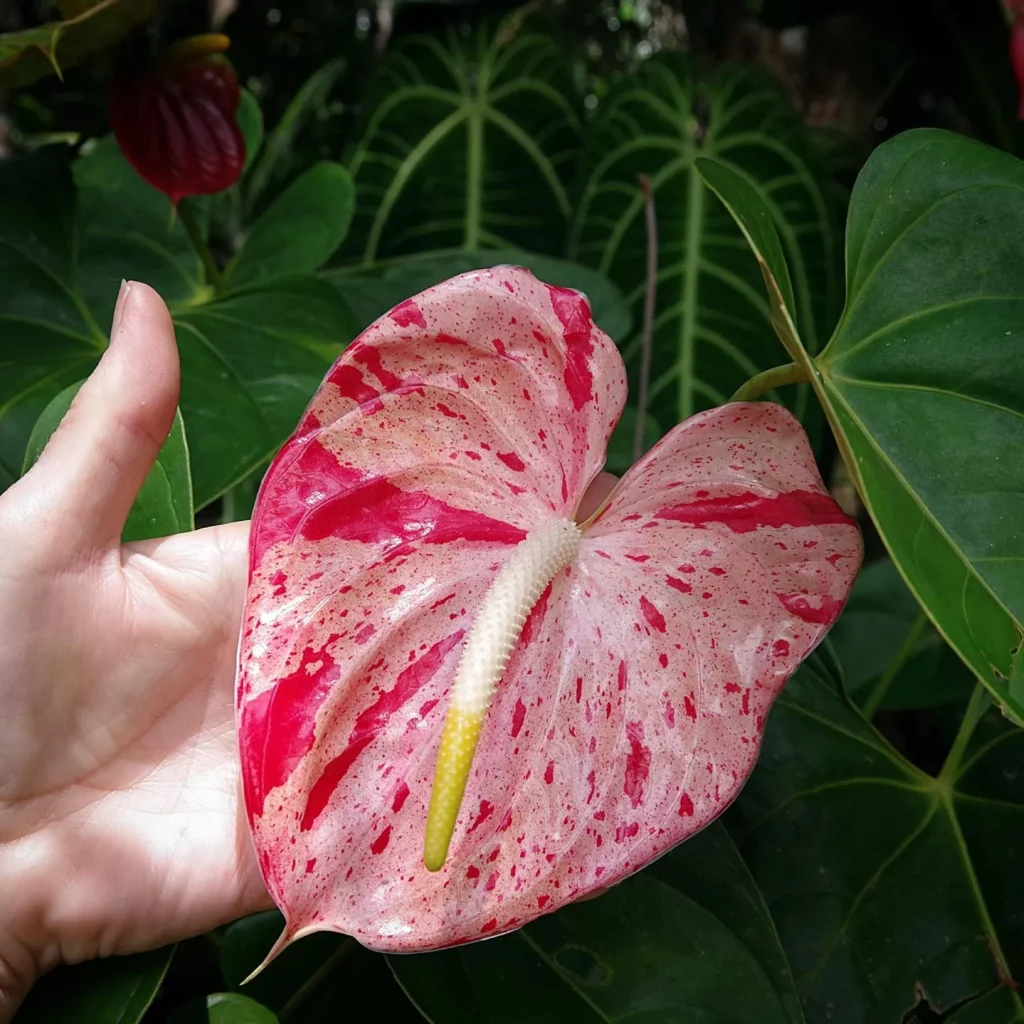The Anthurium regale, or Regal Anthurium, is a captivating exotic plant from the Araceae family, native to Colombia’s Andes mountains. As an epiphytic species, it thrives in shady, high altitude environments. This plant is renowned for its lush green leaves and striking blooms, making it a prized addition to any plant collection. The term “Anthurium regale” translates to “royal anthurium,” reflecting its majestic appearance.
Featuring thick, glossy, heart-shaped leaves with prominent parallel veins, the Regal Anthurium’s foliage can grow up to 3 feet in length, although it typically remains smaller indoors. Its flowers are distinctive, with bright white petals and a pink spadix, reaching up to 6 inches. For indoor cultivation, the Regal Anthurium requires ample indirect light, as direct sunlight can damage its leaves.
When caring for the Anthurium regale indoors, it’s crucial to maintain a warm environment with temperatures ranging between 60-85°F (15-29°C) and high humidity levels above 60%. This can be achieved using a humidifier or a water-filled tray near the plant. With its striking beauty and regal presence, the Anthurium regale is an exceptional choice for those seeking to add a touch of tropical elegance to their plant collection.
Genus Species

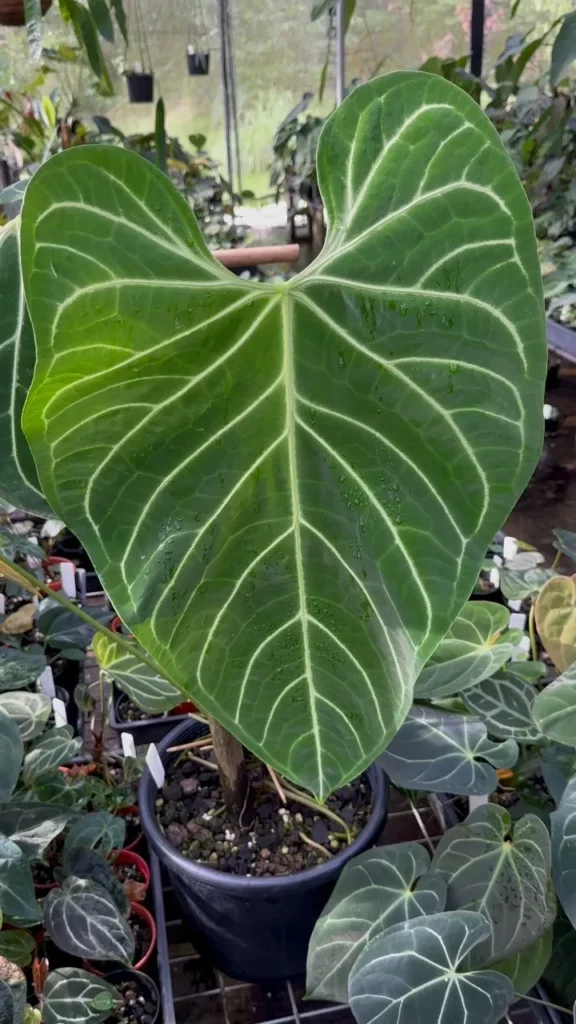
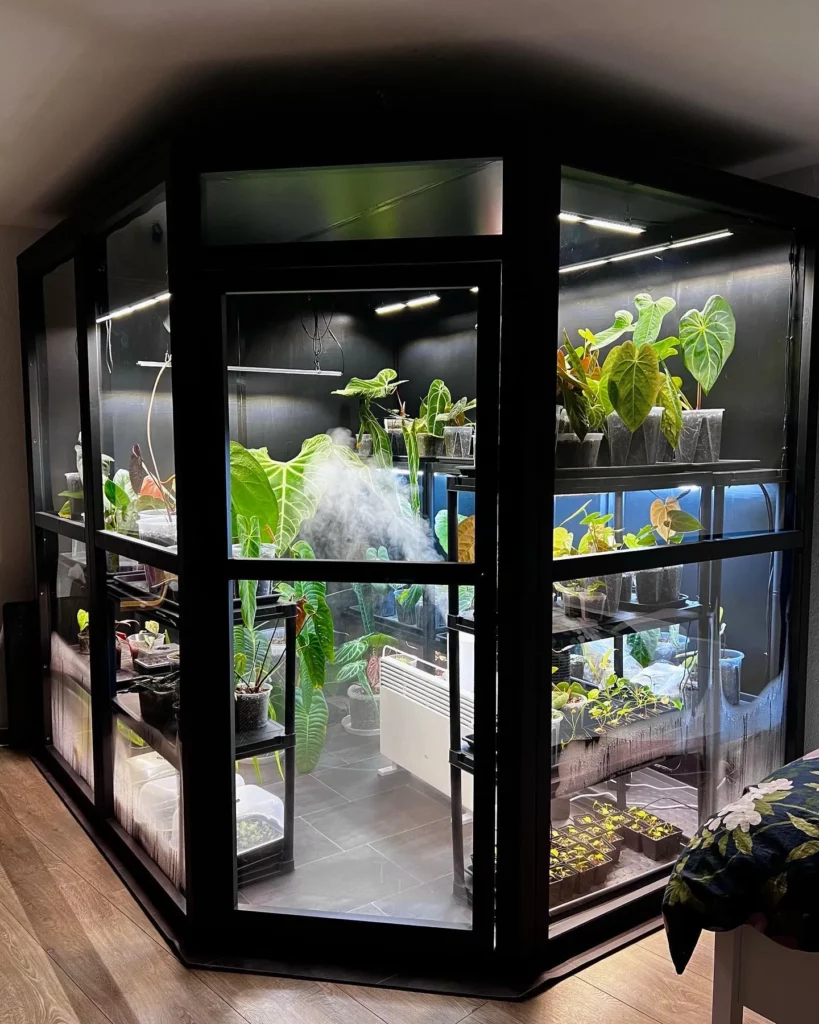
Anthurium regale, commonly known as the Regal Anthurium, is a stunning flowering plant from the Araceae family. This genus of plants is native to Central and South America and contains around 1000 different species. The word Anthurium actually comes from Greek, with “anthos” meaning flower and “oura” meaning tail.
So, in essence, the name Anthurium is referring to the plant’s unique blooming structure. The Regal Anthurium is one of the most sought-after houseplants for its impressive foliage and blooms.
Its striking features include large heart-shaped leaves that can grow up to two feet long, with glossy deep green surfaces and prominent white veins running through them. The flowers themselves are also incredibly beautiful; they’re cone-shaped, bright white in color with yellow spadices sticking out of their centers.
No products found.
As far as care tips go for this plant variety, it’s worth noting that while it does require some maintenance, it’s not an overly difficult plant to care for. However, like any other type of plant in your home or garden, there are certain things you need to keep in mind if you want your Regal Anthurium to thrive.
One of the first things you should consider when growing this plant is where it will be placed. Since these plants are tropical by nature – originating from countries like Ecuador and Colombia – they prefer warm environments with high humidity levels Care Tips.. Therefore, placing them near windows or doors where cold drafts can pass through may not be ideal.
Additionally, as with any species within a particular genus there will be variations amongst individual plants. Despite being a part of the same family as other types of anthuriums like Anthurium andraeanum or Anthurium scherzerianum (both popular cut flower varieties), each type has its own unique preferences when it comes to light exposure Care Tips.. For example, the Regal Anthurium prefers bright filtered light, but not direct sunlight.
Too much sun can cause the leaves to scorch and damage its delicate flowers. Overall, Anthurium regale is a highly ornamental plant that can add plenty of charm to your home or garden.
Anthurium regale – Regal Anthurium Appearance

The Anthurium regale, also known as the Regal Anthurium, is a stunning and unique plant that is highly sought after by plant enthusiasts. One of the most noticeable features of this beautiful species is its large, lush green leaves that can grow up to 3 feet long. The leaves have a velvety texture and are heart shaped with prominent veins running throughout.
If you’re looking for an eye-catching statement piece, the Anthurium regale will not disappoint. Another distinguishing feature of this plant is its inflorescence – the part of the plant that produces flowers.
The Regal Anthurium’s flower spathes are dark green with prominent white veins and can grow up to 10 inches long. However, it’s not just the size of these flowers that makes them impressive; they also have a unique velvet-like texture that sets them apart from other anthurium species.
When it comes to caring for your Anthurium regale, one thing to keep in mind is that these plants are sensitive to direct sunlight. Care Tips: It’s best to keep them in locations with bright but indirect light or filtered light.
This will prevent any sunburn on their delicate leaves and ensure they stay healthy and vibrant. Additionally, it’s important to note that while the Regal Anthurium enjoys high humidity levels, excessive watering can lead to root rot and other fungal diseases.
How To Grow Anthurium regale – Regal Anthurium


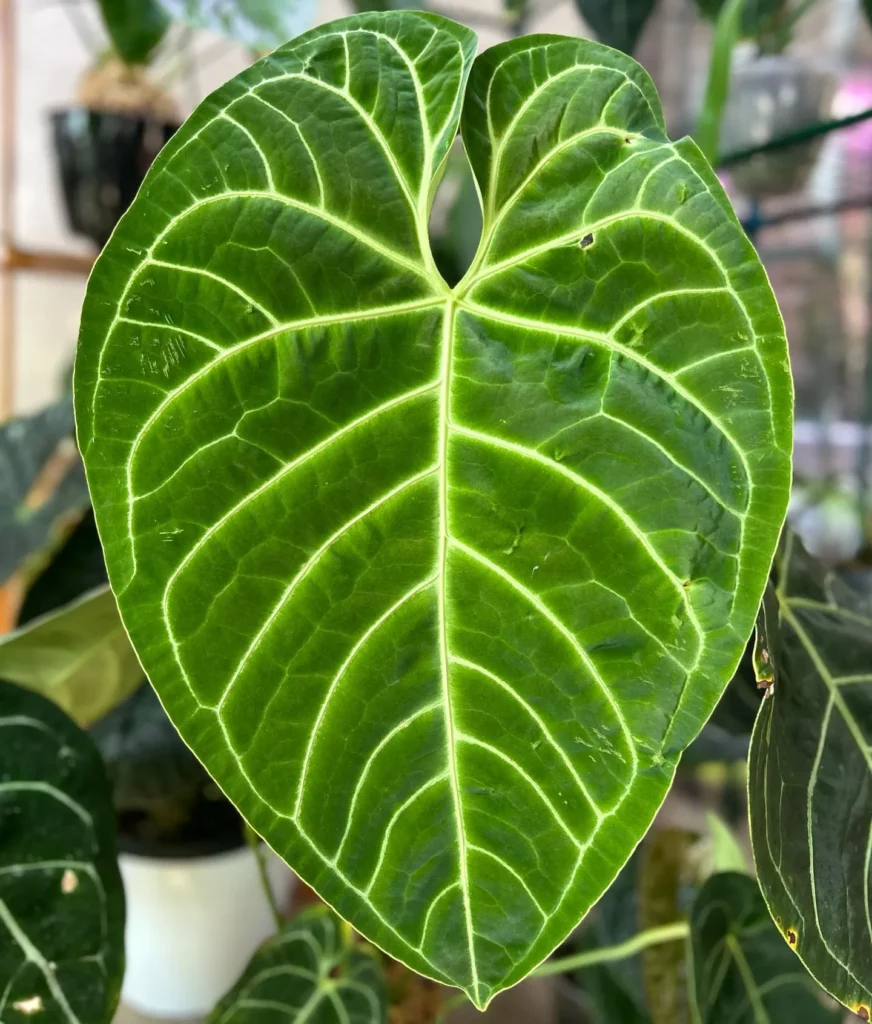
Anthurium regale, known as the Regal Anthurium in the houseplant world, is a stunning plant to grow in your home. However, before you dive into growing one of these beauties, it’s important to know how to properly care for them.
In this section of the article, we’ll be going over how to grow Anthurium regale and all of its unique requirements. First things first, let’s talk about soil.
When it comes to growing Anthurium regale successfully, you need to choose a well-draining soil that retains moisture without becoming soggy. A peat-based mix with some perlite or orchid bark mixed in should do the trick.
It’s also recommended that you add some pebbles or gravel at the bottom of your pot before adding soil to enhance drainage. When it comes to potting your Regal Anthurium, make sure you select a container that provides enough space for its roots while not being too big.
Choosing a too-big pot can lead to issues with overwatering and root rot. A pot with drainage holes is also essential for healthy plant growth.
Lighting is another important factor when it comes to growing an Anthurium regale. They prefer bright indirect light but cannot tolerate direct sunlight as it can scorch their leaves.
No products found.
If possible, place your plant near an east-facing window where they’ll receive plenty of morning light but won’t be hit by harsh afternoon sun rays. Temperature and humidity are two more crucial elements when it comes to growing an Anthurium regale successfully.
These plants thrive in warm temperatures between 65-80°F (18-26°C) during the day and 60-68°F (15-20°C) at night. They also require high humidity levels between 70% – 80%.
You can achieve this by placing a humidifier near your plant or placing a tray filled with pebbles and water under your plant’s pot. Growing an Anthurium regale can be a bit tricky, but it’s definitely worth it for the stunning foliage and flowers.
Keeping the plant’s unique requirements in mind when it comes to soil, potting, lighting, temperature, and humidity is essential for healthy growth. Follow these care tips and watch your Anthurium regale flourish into a beautiful addition to your indoor jungle.
Anthurium regale – Regal Anthurium Propagation Tips
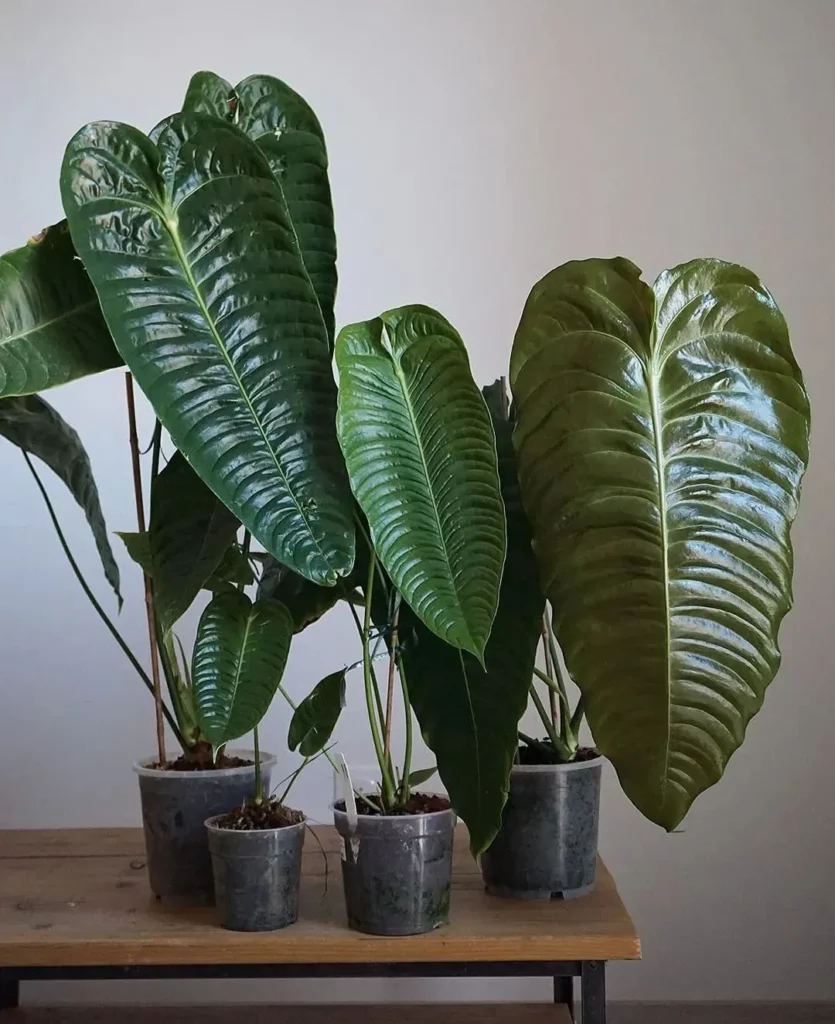
Propagating plants can be a fun and exciting way to expand your plant collection. However, it can also be a bit daunting, especially if you’re new to the world of plant propagation. In this section, we’ll cover some tips for propagating Anthurium regale – Regal Anthurium that will help you get started.
One of the easiest ways to propagate Anthurium regale is through stem cuttings. To do this, simply take a cutting from the parent plant that is approximately six inches long and has at least two leaves.
Carefully remove any lower leaves and place the cutting in a container filled with moist soil. Keep the soil consistently moist and place the container in an area with bright, indirect light.
In about four to six weeks, roots should begin to form. Another method of propagation for Anthurium regale is by dividing the parent plant.
No products found.
To do this, gently remove the parent plant from its pot and carefully separate the roots into two or more sections using a clean knife or scissors. Be sure each section has at least one leaf and some healthy roots attached before repotting them into their individual containers.
If you’re looking for something even easier than stem cuttings or division, another way to propagate Anthurium regale is by planting seeds. Simply collect ripe seeds from an existing plant’s fruit (berries) after they turn red-orange color then gently sprinkle them on top of your soil mix after you’ve watered it well beforehand (to prevent them from being displaced).
Anthurium regale – Regal Anthurium Quick Care Overview


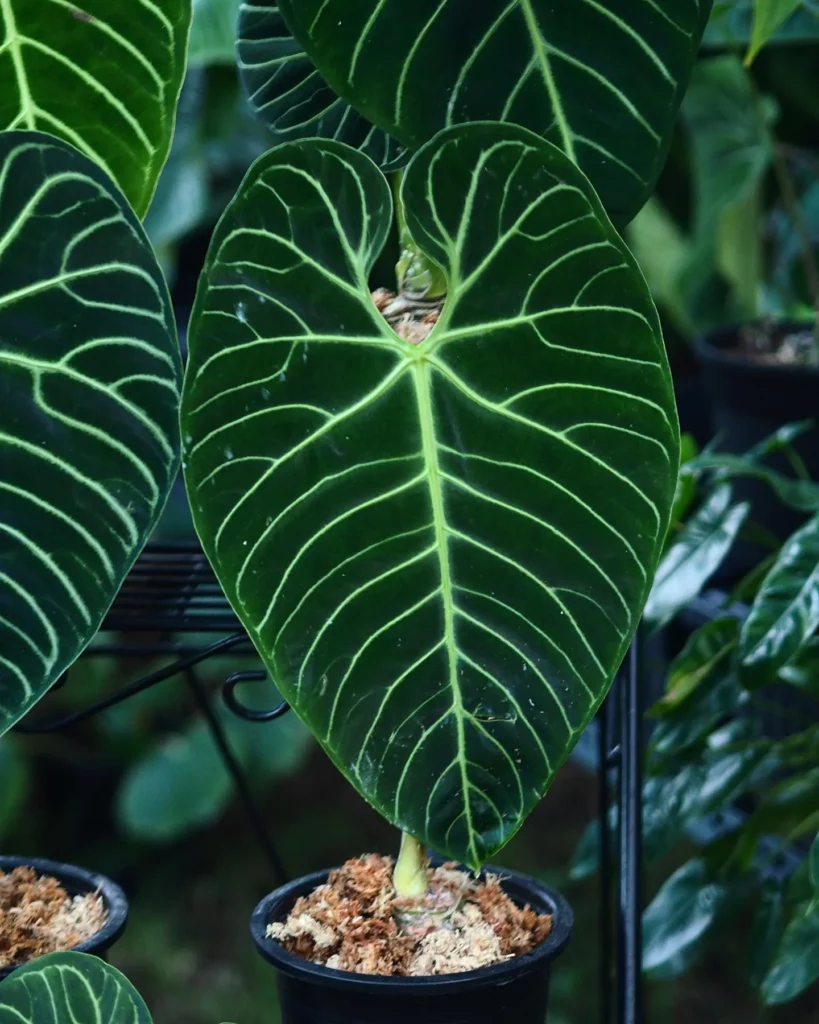
Anthurium regale, commonly known as the Regal Anthurium, is a tropical houseplant that boasts unique features and characteristics. For those looking to add this stunning plant to their collection, it’s important to have a quick care overview on hand. Firstly, the Regal Anthurium is not a low maintenance plant by any means.
While this may deter some, for those willing to put in a bit of effort, the results are truly worth it. When it comes to light requirements, the Regal Anthurium prefers bright but indirect sunlight.
Care Tips: Avoid exposing the plant to direct sunlight as it can cause damage to its leaves. Secondly, when it comes to soil requirements, ensure that you are using well-draining and nutrient-rich soil for your Regal Anthurium.
A well-drained soil ensures that water doesn’t accumulate at the base of the pot leading to roots rotting away. Care Tips: Use high-quality potting soil mixed with perlite or sand and avoid heavy soils like clay-based ones.
Thirdly, watering your Regal Anthurium requires a delicate balance- too much or too little can cause harm. Watering should be done only when the top layer of soil feels dry.
The frequency of watering will depend on factors such as temperature and humidity levels in your home environment. Care Tips: Pay attention to changes in temperature and humidity levels and adjust watering accordingly.
Fertilizing your Regal Anthurium is crucial for its growth and overall health. During spring and summer months use fertilizer once every two weeks at half-strength then reduce feedings during fall or winter months while reducing light exposure too by placing them away from windowsills or bright areas if possible.Care Tips: Use balanced fertilizer with 20-20-20 NPK values for optimal growth.
Anthurium regale – Regal Anthurium Light Requirements

One of the most important care tips for Anthurium regale is to provide it with the right amount of light. This plant requires bright, indirect light to thrive.
Direct sunlight can scorch its leaves and cause permanent damage, but too little light will also harm the plant. The ideal spot for this plant is near a window that receives bright, filtered light all day long.
If you don’t have a window that provides enough natural sunlight, you can supplement with artificial light. Use LED grow lights that provide full-spectrum lighting to mimic natural sunlight as closely as possible.
No products found.
Place the lights 6-8 inches above the plant and keep them on for 10-12 hours a day. It’s essential to avoid exposing Anthurium regale to direct sunlight – even for a short period – as it can cause severe leaf damage.
If you notice any browning or yellowing of leaves, it could be because of excessive exposure to direct sun rays. Another essential factor in providing your Anthurium regale with adequate light is knowing when and how long they need it.
These plants prefer bright morning sun, followed by afternoon shade. Anything longer than six hours of exposure to direct sunlight or sudden changes in lighting conditions could negatively affect their growth.
Anthurium regale – Regal Anthurium Soil Requirements



The soil requirements for Anthurium regale – Regal Anthurium can be quite particular, and it is important to have a good understanding of the type of soil that this plant thrives in. Firstly, it is essential to have a well-draining soil that does not retain water for too long.
The roots of this plant are susceptible to root rot if they are left in wet soil for extended periods. Therefore, a mixture of peat moss and perlite or sand will work wonders.
Another crucial aspect of the soil requirements is the pH level. Ideally, the soil pH should be between 5.5 and 6.5, which is slightly acidic.
No products found.
This acidity level helps with nutrient uptake by the roots while also preventing fungal growth that could be quite problematic for your plant. When choosing your potting mix, make sure to choose one that has high porosity but also retains enough moisture to keep your Anthurium regale – Regal Anthurium hydrated for an extended period without being too damp or soggy.
Care Tips: You can add organic matter to the potting mix such as leaf compost or worm castings. This organic matter will help improve soil quality by adding nutrients and beneficial microorganisms that help promote healthy root growth.
Anthurium regale – Regal Anthurium Potting and Repotting

Potting and Repotting Anthurium regale – Regal Anthuriums can be a bit tricky but with a little care and attention, it’s definitely achievable. When you first bring your Anthurium regale home, it’s essential to repot them.
Potting soil that comes from garden centers is typically too heavy and dense for these plants, making it challenging for water to penetrate through the soil. To avoid these issues, mix organic matter such as peat moss or coconut coir to make a light and well-draining mix.
When repotting your Anthurium regale, ensure that the pot is slightly larger compared to its previous one so that there is enough growing space for the roots. Adding a layer of pebbles or gravel at the bottom of your pot will help with drainage and prevent root rot.
Care Tips: Repot your plant during early spring when it begins its active growth season. Avoid repotting during winter as this will put stress on the plant since it’s not actively growing.
While transplanting your Anthurium regale, take extra care not to damage any of the roots; gently loosen any compacted or tangled roots before placing them in their new container. Once you’ve transplanted your plant into its new pot, give it plenty of water while avoiding oversaturation as this may cause root rot.
Care Tips: During the growing season (spring/summer), fertilize every two weeks using balanced fertilizer diluted in half strength. Proper potting and repotting are essential for keeping an Anthurium regale healthy and thriving.
Anthurium regale – Regal Anthurium Pruning and Shaping



Pruning and Shaping Anthurium regale – Regal Anthurium Anthurium regale – Regal Anthurium is a plant that requires careful pruning and shaping to keep it looking beautiful and healthy. Pruning means removing dead, diseased, or damaged parts of the plant to promote new growth.
Shaping involves trimming to give the plant a particular form or size, which enhances its beauty. Pruning and shaping are essential care tips for Anthurium regale since they help maintain its compactness.
To prune your plant, start by sterilizing your pruning shears with rubbing alcohol and then cutting off any dead or yellowing leaves at the base of the stem. If there are any damaged stems, cut them back to healthy tissue.
You can also remove overcrowded foliage to enhance air circulation. Shaping your Anthurium regale should be done after pruning.
You can choose different shapes depending on your preference; however, ensure you don’t cut off too much foliage leading to stunted growth or death of the plant. For instance, if you want a bushy appearance, trim off the tips of longer stems in areas where you want it bushier.
When shaping Anthurium regale, always leave some leaves on each stem as they provide nutrients for new growth. Care tips such as avoiding cutting below the existing leaf nodes will encourage branching out for more foliage eventually.
Anthurium regale – Regal Anthurium Temperature Requirements
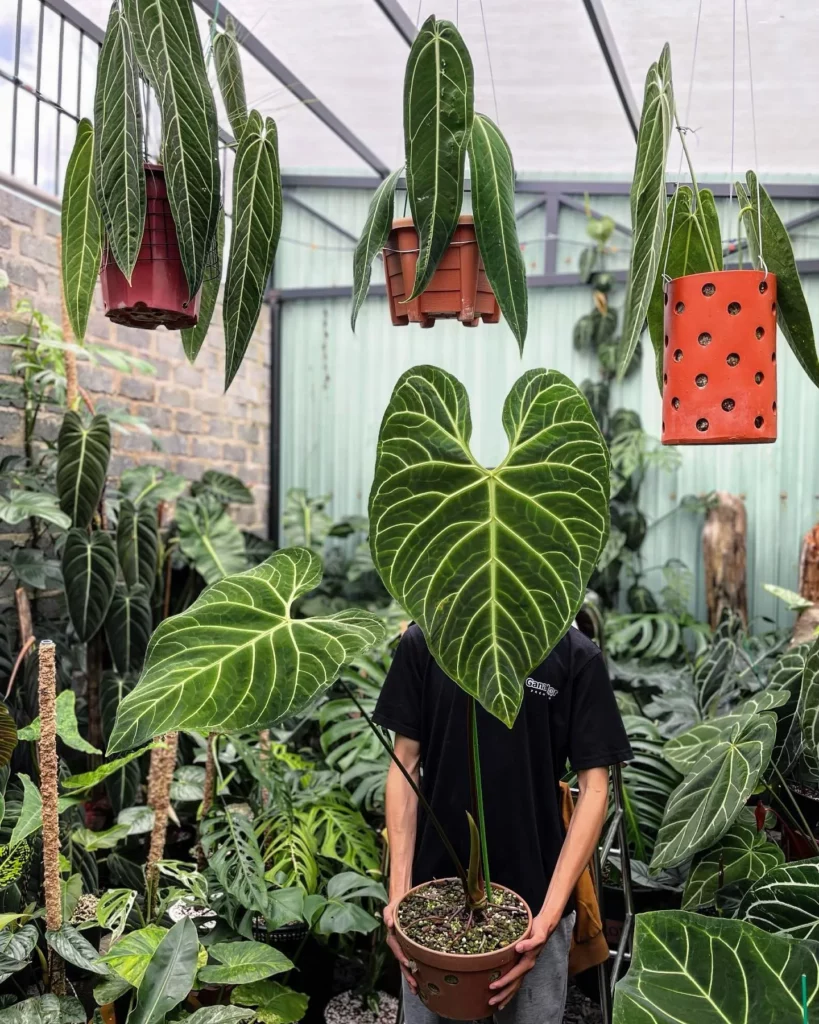
When it comes to temperature requirements, Anthurium regale is a bit of a finicky plant. It needs specific conditions to thrive, and if those conditions are not met, the plant can suffer. The ideal temperature range for this plant is between 60°F and 80°F (15°C-27°C).
Any temperatures outside of this range can cause stress and damage to the plant. If you live in an area with fluctuating temperatures or extreme cold, you may want to consider keeping your Anthurium regale indoors.
This way, you can control the temperature and keep it within the ideal range. Care Tips: If you do decide to keep your Anthurium regale outdoors in cooler temperatures, make sure that it is protected from drafts and wind.
Another aspect of temperature that is important for Anthurium regale care is nighttime temperatures. During the nighttime hours, these plants need a slight drop in temperature, ideally between 55°F and 65°F (13°C-18°C).
This drop helps the plants enter a state of rest and rejuvenation before springing back to life during the day. Care Tips: If your home’s temperature doesn’t dip low enough during nighttime hours naturally, consider using a programmable thermostat or air conditioning unit with this feature.
On the other hand, hot temperatures can also be detrimental to Anthurium regale. When exposed to prolonged periods of high heat above 85°F (29°C), these plants become stressed out which leads them vulnerable to pests infestations such as spider mites or thrips .
Additionally they will have droopy leaves that will quickly give away their discomfort from overheating. Care Tips: When summer arrives along with scorching hot temps be sure that your Regal Anthurium has access to shade at all times – use curtains or blinds if necessary in direct sun exposure areas – add trays filled with rocks on which water evaporates to the room or spray the leaves with water regularly and keep your plant well hydrated.
Humidity Requirements
Anthurium regale – Regal Anthuriums are tropical plants that thrive in high humidity environments.
This means that if you want your Anthurium regale to grow healthy, you must provide the right level of humidity. If the air is too dry, your plant will suffer and may even die.
The ideal humidity level for Anthurium regale – Regal Anthuriums is between 80% and 90%. This may seem like a lot, but it’s necessary to replicate their natural habitat.
A good way to measure humidity levels is using a hygrometer. It’s an essential tool for any serious indoor gardener.
If you live in an area with low humidity, don’t worry; there are ways to increase it artificially. The easiest method is by using a humidifier.
There are many types of humidifiers available in the market, from small ones suitable for single rooms to large ones capable of increasing humidity levels across your entire house. Another alternative is placing your plant on a tray filled with pebbles and water.
Fill the tray with water up to just below the top of the pebbles and place your pot on top of them. The water will evaporate over time, increasing humidity around the plant.
Care Tips: Avoid misting directly onto your Anthurium regale’s leaves as this can encourage fungal diseases due to prolonged moisture on the surface of leaves. Instead, mist above or around your plant so that droplets fall like rain and avoid moisture sitting directly on leaves or foliage.
Maintaining high humidity levels is essential for growing a healthy Anthurium regale – Regal Anthuriums indoors. Use a hygrometer to monitor levels regularly and choose one of the many available methods such as humidifiers or trays filled with pebbles and water that suit your needs best when raising humidity levels at home or office space.
Watering Anthurium regale – Regal Anthurium
Watering is one of the most important aspects of Anthurium regale care. As a tropical plant, it’s accustomed to consistent moisture, but not necessarily standing water or soggy soil.
It’s crucial to strike a balance between keeping the soil moist enough and avoiding overwatering. Overwatering can lead to root rot, which can be fatal for your Anthurium regale.
So how do you ensure that your Anthurium regale is getting just the right amount of moisture? One key thing to keep in mind is that this plant prefers quality over quantity when it comes to watering.
That means that instead of watering frequently but superficially, you’re better off waiting until the top inch or so of soil has dried out and then providing a thorough deep watering. Another important factor in watering your Anthurium regale is how much light it’s receiving.
The more sunlight it gets, the more quickly its soil will dry out and need watering again. Conversely, if your plant is in lower light conditions, it may require less frequent watering.
Care Tips: To ensure that you’re providing appropriate levels of moisture for your Anthurium regale, consider investing in a moisture meter or using the finger test method where you stick your finger about an inch into the soil and check for dampness. Also make sure to use well-draining potting mix such as orchid bark mixed with perlite or vermiculite.
In addition to getting the amount right, you should also pay attention to how you’re delivering water to your Anthurium regale. One way to provide adequate moisture without drowning your plant is by bottom-watering rather than top-watering.
To do this, simply fill up a tray with water and place your potted Anthurium on top so that it can soak up water from below. Remember that Anthurium regale is a plant that prefers consistency in watering.
This means that if you’re going to be away from home for an extended period, make arrangements for someone to water your plant on a schedule so that it doesn’t dry out or get overwatered in your absence. Care Tips: While Anthurium regale can tolerate some degree of drought, it’s much less forgiving when it comes to overwatering.
Fertilizing Anthurium regale – Regal Anthurium
When it comes to fertilizing Anthurium regale or any other plant, it’s essential to understand what it needs. If you want a healthy and lush Anthurium regale, then fertilizer is your best friend.
However, too much of anything can harm your plant. When you provide too much or too little fertilizer, things can go wrong quickly.
Before you start fertilizing, take a look at the soil type, light exposure, and other environmental factors as they all impact how much nutrients are available in the soil for the plant to absorb. For instance, if your Anthurium regale is in bright indirect light with well-draining soil, then its nutrient requirements will differ from those in low-light conditions with heavy soils.
Care Tips: Over-fertilizing causes more harm than underfertilization. A common mistake a lot of people make is thinking that more fertilizer will result in faster growth.
This is misguided because overfertilization leads to an overgrowth of the leaves while stunting root growth – a recipe for disaster. The best way to fertilize your Anthurium regale is through slow-release pellets that release nutrients over time and prevent leaching by watering.
You could also use liquid fertilizers diluted down to half their recommended strength and applied every two weeks during growing seasons. A soil test kit will help determine the right nutritional balance for your plant based on its current state and recommend the appropriate course of action for maximum growth potential.
Fertilization should not be done haphazardly – instead use proper timing and amounts at regular intervals for optimal results without harm. Only then can you expect beautiful blooms from your beloved Anthurium regale!
Pest Control Tips for Anthurium regale – Regal Anthurium
Anthurium regale – Regal Anthurium is a beautiful and popular houseplant. However, like any other plant, it’s prone to pests which can harm its growth and appearance.
In this section, we’ll discuss pest control tips for Anthurium regale – Regal Anthurium so that you can keep your plant healthy and beautiful. The most common pests found on Anthurium regale – Regal Anthurium are spider mites, mealybugs, thrips and scale insects.
Spider mites are tiny pests that feed on the sap of the plant causing discoloration and wilting. Mealybugs are cottony white insects that suck the juices from the plant leading to stunted growth.
Thrips are slender insects that cause damage to new leaves and flowers by feeding on them while scale insects look like small bumps on the stem or leaf of the plant. To keep your Anthurium regale – Regal Anthurium free from these pests, it’s important to monitor its health regularly.
Look for signs of damage such as yellowing or browning leaves or presence of webs or bites marks on leaves or stems. Inspect both sides of the leaves as some pests may hide under them.
One way to control pests is by using insecticidal soaps which can be bought in stores or made at home using mild dish soap mixed with water. Spray this mixture directly onto affected areas making sure to cover both sides of the leaves as well as stems.
It’s also important to wipe off excess soap from plants after spraying since it can cause leaf burn if left undisturbed. Another effective pest control method is neem oil which is a natural pesticide derived from neem tree seeds.
Neem oil works by disrupting insect feeding patterns and hindering their growth rate eventually leading to their death. Apply neem oil using a spraying bottle or wiping the leaves with a cloth soaked in the oil.
Care Tips: When applying neem oil, it’s important to protect your skin and eyes as it can cause irritation. Pests can be a real threat to your Anthurium regale – Regal Anthurium plant’s health and appearance.
However, by monitoring its health regularly and applying the right pest control methods like insecticidal soaps or neem oil, you can keep your plant healthy and beautiful for years to come. Remember, prevention is always better than cure so make sure you keep your plant environment clean and avoid bringing infected plants in close proximity to your Anthurium regale – Regal Anthurium.
Anthurium regale – Regal Anthurium Common Problems
Despite being considered an easy-to-grow plant, the Anthurium regale – Regal Anthurium is not impervious to issues.
The most common problems that arise with this plant are yellowing leaves, root rot, fungal diseases and pests. The first problem that many people face with their Anthurium regale – Regal Anthurium is yellowing leaves.
This can be caused by a variety of issues, including overwatering, underwatering, too much direct sunlight or lack of nutrients. To avoid this problem from occurring care tips include monitoring the moisture level in the soil and ensuring that it’s not too damp or dry.
In addition to this, providing sufficient amounts of indirect sunlight and feeding your plant regularly can also help prevent leaf yellowing. Root rot is another common issue that affects many houseplants including the Anthurium regale – Regal Anthurium.
Root rot occurs when there is excess water in the soil for extended periods of time which leads to a buildup of bacteria or fungi in the roots causing them to become mushy and brown. To avoid this problem care tips include avoiding overwatering your plant by only watering it when the top layer of soil feels dry to touch.
Additionally, using well-draining soil mixtures can help prevent root rot as they allow moisture to move through quickly without causing any water-logging. Fungal diseases are one of the most difficult problems to deal with for any houseplant owner as they’re often hard to diagnose and treat effectively.
Some common fungal infections that can affect your Anthurium regale – Regal Anthurium include leaf spot disease or powdery mildew which presents as white patches on leaves or flowers respectively. Care tips include ensuring proper air circulation around your plants by placing them in an area with good ventilation or installing a fan nearby if necessary.
Pests can be a big problem for Anthurium regale – Regal Anthuriums. Common pests that can attack your plant include mealybugs, spider mites or scale insects which can cause significant damage if left untreated.
Care tips include keeping an eye out for signs of infestation such as sticky residue on the leaves or small white webs on the plant. Taking action early by using insecticide soap or other natural remedies can help prevent pests from causing irreparable damage to your plant.
Frequently Asked Questions
Anthurium Regale can be considered a bit more demanding in terms of care compared to some other houseplants. It requires specific conditions such as high humidity, warm temperatures, and bright, indirect light. Consistent attention to its environmental needs and proper care will contribute to its well-being.
Anthurium Regale prefers a high humidity level, ideally around 70-80%. You can achieve this by placing the plant on a humidity tray, using a humidifier, or grouping it with other plants to create a microclimate. Regular misting of the leaves can also help increase humidity, but be cautious not to overdo it to avoid fungal issues.
To care for an Anthurium plant indoors, provide it with bright, indirect light, such as placing it near an east or west-facing window. Keep the soil consistently moist but not waterlogged, allowing the top inch to dry out between waterings. Maintain a temperature range of 65-80°F (18-27°C) and provide regular fertilization during the growing season.
Yellow spots on Anthurium Regale leaves can be caused by various factors, including overwatering, exposure to direct sunlight, nutrient deficiencies, or pest infestation. Evaluate the plant’s watering schedule, ensure it is receiving the right amount of light, consider fertilizing with a balanced houseplant fertilizer, and inspect the leaves for signs of pests like spider mites or mealybugs. Proper diagnosis and addressing the underlying issue will help prevent further damage to the plant.
After reading this, check out our other articles on:
Conclusion
Anthurium regale – Regal Anthurium is a stunning houseplant that deserves to be in every plant lover’s collection. With its large, glossy leaves and striking blooms, it’s sure to impress anyone who sees it.
However, caring for this plant can be a challenge, especially for those new to the world of indoor gardening. But fear not – with the right know-how and some perseverance, you can give your Regal Anthurium the love and care it needs to thrive.
When it comes to caring for your Anthurium regale – Regal Anthurium, the key is consistency. Make sure you’re providing the right light levels, soil conditions, and watering schedule on a regular basis.
This will help ensure that your plant stays healthy and happy over the long term. One of the most important care tips for Anthurium regale – Regal Anthurium is to avoid overwatering.
This plant is sensitive to root rot and other moisture-related issues, so be sure not to keep its soil too damp or allow water to accumulate in its base. Additionally, be careful not to let your plant sit in direct sunlight or too close to heaters or other heat sources.
Another important factor in caring for your Anthurium regale – Regal Anthurium is fertilization. While this plant doesn’t need as much fertilizer as some others do (thanks in part to its slow growth rate), it still benefits from occasional feedings during its active growing season.
Don’t be afraid to experiment with different potting arrangements or pruning techniques until you find what works best for your particular plant. Every individual has different needs when it comes to indoor gardening – so don’t worry if your approach doesn’t match up exactly with what you’ve read elsewhere.
In short, while caring for an Anthurium regale – Regal Anthurium can be challenging at times, it’s also a rewarding experience that offers plenty of opportunities to learn new things about the world of indoor gardening. So if you’re up for the challenge, go for it – and enjoy watching your beautiful plant thrive under your watchful eye.



